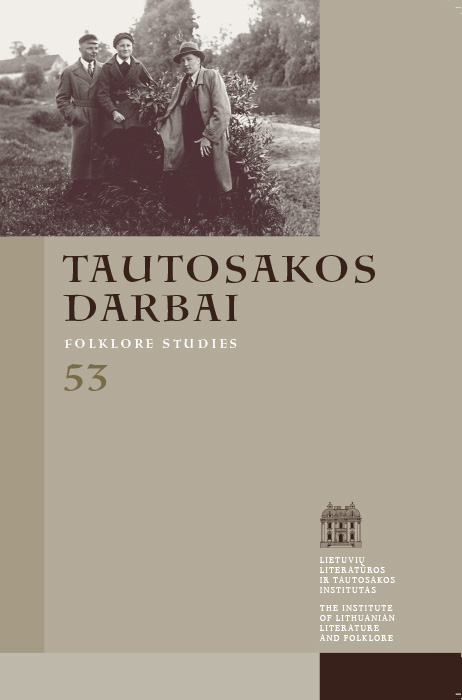“God-Maker” in Lithuanian Village of the End of the 19th – the First Half of the 20th Century: an Artist and / or a Craftsman
Abstract
The article focuses on the issue of creative freedom exercised by the self-educated folk carvers – the so-called dievdirbiai (literally, “god-makers”), discussing whether the “godmaker” was free to create or if his creative freedom was limited, and if so – by whom, to what extent and why.
In the 19th – the first half of the 20th century, the “god-making” constituted a branch of the wood processing craft, and its practitioners were primarily artisans seeking to make their living from this trade or earn some additional income. No artisan worked without first receiving demand or requests. These people were exceptional individuals characterized by high creative capacities, outstanding mastership in various crafts, resourcefulness, sometimes also by peculiar ways of behavior, appearance or mode of life that deviated from the traditional established patterns, therefore frequently labelled as weirdos.
In order to be in demand and enhance their selling rate, the “god-makers” sought recognition as renowned masters. The recognition chiefly rested on the opinion of the parish priest. Priests frequently denounced works characterized by primitive plastics, even declining to sanctify them. However, according to the popular opinion, sanctifying of the statuettes meant their positive recognition. Besides, the unsanctified “gods” were widely believed to have no power. Therefore, masters endeavored to comply with the customers’ wishes, also adhering to the demands that essentially involved following the standards of the Christian iconography and implied making easily recognizable saints. Another popular request was making the statuettes as realistic as possible.
The masters usually complied with the above-mentioned demands, therefore adhering to the main schemes of iconographic composition. However, they exercised certain degree of freedom in terms of interpreting attributes, details and colors of clothing (particularly in case of female saints), and introducing certain motives related to the folk worldview or peculiarities of peasant daily life and clothing.
Occasional connections of iconographic types occurring in folk sculpture can also be regarded as manifestations of creativity and rather liberal interpretation of plots. The “godmakers” were particularly prone to integrate several plots related to Virgin Mary, perhaps attempting to enhance the expressive qualities of the statuettes and highlight the importance of the God’s Mother in the human life. Especially Mary’s head used to be ingeniously adorned in an attempt to emphasize her image as the Heavenly Queen.
Thus, some “god-makers” retained originality in their work: rather than mechanically copying prototype compositions, poses and details, they would reshape them in their own way, integrating into a harmonious whole, preserving their distinctive style of carving, enduing statuettes with certain emotional expression, varying the same plots in terms of poses, details, and clothing. However, others approached the produce of the church workshops, adding nearly no individual features and just closely reiterating the prototypes.
In the traditional village community of the 19th – the first half of the 20th century, creativity and craft went hand in hand. The “god-maker” was both an artisan and an artist. The opposition between craft and creative work acquired distinct shape only in modern times. Previously, neither customers’ requests nor established notions regarding following of the prototypes seemed to the “god-maker” as limiting his creative freedom. He created interpreting things against the framework of specific rules at the time when object of art was not yet separate from the object of worship. Thus, requirement to adhere to the iconography seemed natural, since the prime concern for people of the time was the message conveyed by the statuette, i. e. the meaning of its plot rather than its artistic expression.
From the modern point of view, we should discuss the question of relationship between creativity and craft in the “god-making” only in regard to the individual masters – by comparing their compositions, expressive means and details. In some cases, there would be ample creative features, while in others creativity would appear scant, or just an attempt at precise copying of the prototype would be spotted. However, an approach based on the recent scholarly discourse is also possible, suggesting transcending the typical modernist notion and promoting wider perception of creativity, that would diminish the gap between notions of original and its copy, art and craft, innovation and tradition in the daily life. Then the works of the “god-making” masters striving at precise copying of the prototypes may also be regarded as manifestations of creativity.
